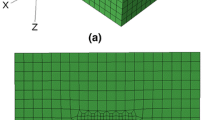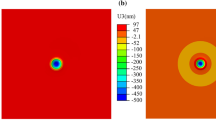Abstract
A crystal plasticity finite element method (CPFEM) model has been developed to investigate the effects of BW hardening model parameters on nano-indentation deformation behaviour and texture evolution. The developed model has been validated by comparison with experimental observations. The simulated results show that the changes of the reference value of slip γ0 and the reference strain rate à affect the indentation mechanical behaviour most significantly, but the changes of the initial hardening modulus h0 affect the indentation mechanical behaviour most insignificantly. It also has been found the variations of the reference value of slip γ0 do not affect the pole figure evolution while pole figures change with the changing of adot value. Both γ0 and adot do not change the value of equivalent strain rate significantly
Access this chapter
Tax calculation will be finalised at checkout
Purchases are for personal use only
Preview
Unable to display preview. Download preview PDF.
Similar content being viewed by others
References
Vlassak, J.J. and W.D. Nix, Measuring the Elastic Properties of Anisotropic Materials by Means of Indentation Experiments. Journal of the Mechanics and Physics of Solids, 1994. 42(8): p. 1223–1245.
Fleck, N.A. and J.W. Hutchinson, Strain gradient plasticity. Advances in Applied Mechanics, Vol 33, 1997. 33: p. 295–361.
Fleck, N.A., et al., Strain Gradient Plasticity — Theory and Experiment. Acta Metallurgica Et Materialia, 1994.42(2): p. 475–487.
Taylor, G., Plastic strain in metals. J Inst Metals, 1938. 62: p. 307–324.
Wu, T.Y., J.L. Bassani, and C. Laird, Latent Hardening in Single-Crystals .1. Theory and Experiments. Proceedings of the Royal Society of London Series a-Mathematical Physical and Engineering Sciences, 1991.435(1893): p. 1–19.
Bassani, J.L. and T.Y. Wu, Latent Hardening in Single-Crystals .2. Analytical Characterization and Predictions. Proceedings of the Royal Society of London Series a-Mathematical Physical and Engineering Sciences, 1991. 435(1893): p. 21–41.
Huang, Y., et al., A study of microindentation hardness tests by mechanism-based strain gradient plasticity. Journal of Materials Research, 2000.15(8): p. 1786–1796.
Huang, Y., et al., A model of size effects in nano-indentation. Journal of the Mechanics and Physics of Solids, 2006. 54(8): p. 1668–1686.
Nix, W.D. and H.J. Gao, Indentation size effects in crystalline materials: A law for strain gradient plasticity. Journal of the Mechanics and Physics of Solids, 1998. 46(3): p. 411–425.
Gao, H.J. and Y.G. Huang, Geometrically necessary dislocation and size-dependent plasticity. Scripta Materialia, 2003. 48(2): p. 113–118.
Gao, H., et al., Mechanism-based strain gradient plasticity — I. Theory. Journal of the Mechanics and Physics of Solids, 1999. 47(6): p. 1239–1263.
Huang, Y., et al., Mechanism-based strain gradient plasticity — II. Analysis. Journal of the Mechanics and Physics of Solids, 2000. 48(1): p. 99–128.
Liu, Y., et al., Combined numerical simulation and nanoindentation for determining mechanical properties of single crystal copper at mesoscale. Journal of the Mechanics and Physics of Solids, 2005. 53(12): p. 2718–2741.
Liu, Y., et al., Orientation effects in nanoindentation of single crystal copper. International Journal of Plasticity, 2008. 24(11): p. 1990–2015.
Casals, O., J. Ocenasek, and J. Alcala, Crystal plasticity finite element simulations of pyramidal indentation in copper single crystals. Acta Materialia, 2007. 55(1): p. 55–68.
Alcala, J., O. Casals, and J. Ocenasek, Micromechanics of pyramidal indentation in fcc metals: Single crystal plasticity finite element analysis. Journal of the Mechanics and Physics of Solids, 2008. 56(11): p. 3277–3303.
Asaro, R.J., Crystal Plasticity. Journal of Applied Mechanics-Transactions of the Asme, 1983. 50(4B): p. 921–934.
Taylor, G.I., The Mechanism of Plastic Deformation of Crystals. Part I. Theoretical. Proceedings of the Royal Society of London. Series A, 1934. 145(855): p. 362–387.
Kocks, U.F. and T.J. Brown, Latent hardening in aluminum. Acta Metallurgica, 1966.14(2): p. 87–98.
Keh, N.a., Latent hardening in iron single crystals Acta Metallurgica, 1966. 14: p. 961–973.
Basinski, J., Latent hardening and the flow stress in copper single crystals J. Phys, 1967. 45: p. 707–735.
Havner, K.S. and A.H. Shalaby, A Simple Mathematical Theory of Finite Distortional Latent Hardening in Single Crystals. Proceedings of the Royal Society of London. A. Mathematical and Physical Sciences, 1977. 358(1692): p. 47–70.
Hutchinson, J.W., Elastic-Plastic Behaviour of Polycrystalline Metals and Composites. Proceedings of the Royal Society of London. A. Mathematical and Physical Sciences, 1970. 319(1537): p. 247–272.
Robert J. A., W.H. John, and Y.W. Theodore, Micromechanics of Crystals and Polycrystals, in Advances in Applied Mechanics. 1983, Elsevier. p. 1–115.
Bassani, J.L. and T.-Y. Wu, Latent Hardening in Single Crystals II. Analytical Characterization and Predictions. Proceedings of the Royal Society of London. Series A: Mathematical and Physical Sciences, 1991. 435(1893): p. 21–41.
Hutchinson, J.W., Bounds and Self-Consistent Estimates for Creep of Polycrystalline Materials. Proceedings of the Royal Society of London Series a-Mathematical Physical and Engineering Sciences, 1976. 348(1652): p. 101–127.
Kumar, A.V. and C.H. Yang, Study of work hardening models for single crystals using three dimensional finite element analysis. International Journal of Plasticity, 1999. 15(7): p. 737–754.
R, H., Generalized constitutive relations for incremental deformation of metal crystals by multislip. Journal of the Mechanics and Physics of Solids, 1966. 14(2): p. 95–102.
YG, H., A user-material subroutine incorporating single crystal plasticity in the ABAQUS finite element program. 1991, Harvard University.
Huang, Y.G., Mech. Report 178. 1991, Harvard University.
Wei, Y.G., X.Z. Wang, and M.H. Zhao, Size effect measurement and characterization in nanoindentation test. Journal of Materials Research, 2004. 19(1): p. 208–217.
McElhaney, K.W., J.J. Vlassak, and W.D. Nix, Determination of indenter tip geometry and indentation contact area for depth-sensing indentation experiments. Journal of Materials Research, 1998. 13(5): p. 1300–1306.
Voyiadjis, G.Z. and R. Peters, Size effects in nanoindentation: an experimental and analytical study. Acta Mechanica, 2010. 211(1–2): p. 131–153.
Inamura, T., et al., Anisotropy and temperature dependence of Young’s modulus in textured TiNbAI biomedical shape memory alloy. Materials Transactions, 2005.46(7): p. 1597–1603.
Oliver, W.C. and G.M. Pharr, An Improved Technique for Determining Hardness and Elastic-Modulus Using Load and Displacement Sensing Indentation Experiments. Journal of Materials Research, 1992. 7(6): p. 1564–1583.
Author information
Authors and Affiliations
Editor information
Rights and permissions
Copyright information
© 2014 TMS (The Minerals, Metals & Materials Society)
About this paper
Cite this paper
Liu, M., Lu, C., Tieu, K.A. (2014). Crystal Plasticity Fem Study of The Effects of BW Hardening Model Parameters on Nano-Indentation Deformation Behaviour of Copper Single Crystal. In: TMS 2014: 143rd Annual Meeting & Exhibition. Springer, Cham. https://doi.org/10.1007/978-3-319-48237-8_41
Download citation
DOI: https://doi.org/10.1007/978-3-319-48237-8_41
Publisher Name: Springer, Cham
Print ISBN: 978-3-319-48593-5
Online ISBN: 978-3-319-48237-8
eBook Packages: Chemistry and Materials ScienceChemistry and Material Science (R0)




